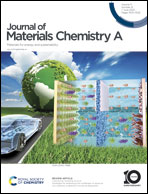Hierarchical Co1.4Ni0.6P@C hollow nanoflowers assembled from ultrathin nanosheets as an anode material for high-performance lithium-ion batteries†
Abstract
The rapid development of lithium ion batteries (LIBs) urgently requires anode materials with structural stability and long cycle stability, especially the cycle performance at high current densities. Herein, a series of carbon-based bimetallic Co2−xNixP hollow nanoflowers (Co2−xNixP@C HNFs) with different amounts of Ni2+ doping are synthesized by a simple solvothermal and phosphating process. Through Mott–Schottky and EIS tests, it is found that the introduction of a small proportion of Ni atoms to form Co1.4Ni0.6P@C HNFs can produce the optimal electronic structure, increase the electronic conductivity and improve the reaction kinetics. In addition, the hollow hierarchical structure of Co1.4Ni0.6P@C HNFs with ultrathin nanosheets accommodates volume expansion, prevents pulverization and aggregation issues of composite materials, and maintains the structural stability during cycling to promote outstanding electrochemical performance. Furthermore, the carbon protective layer of Co1.4Ni0.6P@C HNFs can further enhance structural stability and improve conductivity, greatly enhancing ion and electron transport to promote long-term cycle stability. Therefore, the Co1.4Ni0.6P@C HNFs as an anode material for record lithium-ion storage exhibits an excellent cycling stability (capacity decay of 0.0015% per cycle over 8000 cycles at 5.0 A g−1) and a high rate capacity (240.6 mA h g−1 at 10.0 A g−1). This work provides a potential way to develop high performance lithium-ion storage materials.



 Please wait while we load your content...
Please wait while we load your content...